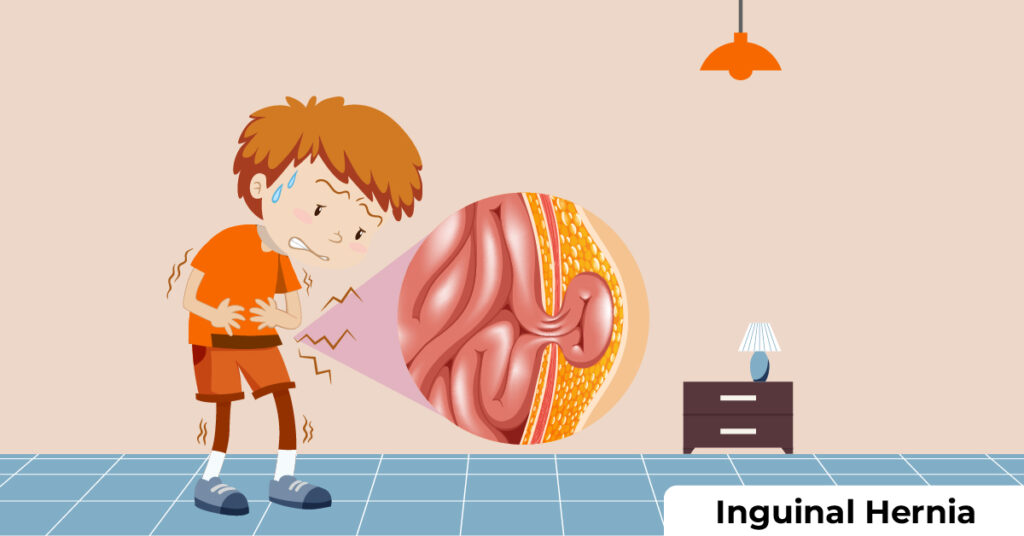
Ques 1 What is Hernia?
Ans. A hernia is a defect or weakness of the abdominal wall where tissue — typically intestines — or fat can project through and cause a bulge. Hernias tend to be more common in adults, but they can also affect children and babies. Inguinal (groin) and (belly button) hernias are the most common types in children and babies.
Ques 2 What is Inguinal Hernias?
Ans. Inguinal hernias are in the groin. These can present as a small bulge in the groin or extend all the way into the scrotum or labia. Most hernias in babies and children are inguinal hernias; they occur in about 1% to 5% of infants and children. Inguinal hernias are more common in premature infants, and occur 10 times more frequently in boys than in girls.
There are two types of inguinal hernias:
- Indirect inguinal hernia: These are caused by an opening in the abdominal wall that is present at birth. Inguinal hernias in babies and children are almost always indirect.
- Direct inguinal hernia: These rarely affect children. The opening in the abdomen wall usually develops during adulthood, typically the result of age, overexertion, sports or heavy lifting.
Ques 3 What are Incarcerated and Strangulated Hernias?
Ans. Sometimes part of the intestine gets stuck in the abdominal opening, a condition called incarceration. If tissue remains incarcerated for a long time, strangulation may develop. Strangulation cuts off the blood supply to that part of the intestine. This condition can result in loss of the strangulated intestine or the involved ovary or testicle. This is a surgical emergency, and strangulation of the bowel can be life-threatening.
Signs of a strangulated hernia include:
- Bloating
- Fever
- Lump or bulge that is larger than before and does not regress spontaneously
- Nausea and vomiting
- Redness and tenderness around the hernia
- Sudden, severe abdominal or groin pain
Ques 4 What Causes An Inguinal Hernias in a Child?
Ans. Openings in the abdominal wall are normal in babies, and typically close before or right after birth. Hernias in babies and children usually develop when these openings do not close, allowing the intestines or other organs to push through the openings. The hernia might develop soon after birth, or years later during childhood.
Ques 5 What are the Hernia Risk Factors in Children and Babies?
Ans. Factors that increase a child’s risk of hernia include:
- Birth weight: Hernias are more common in premature, underweight babies.
- Gender: Inguinal hernias are more common in boys.
- Genetics: Hernias are more common for those with a family history of them.
- Medical conditions: Undescended testicles, cystic fibrosis, a need for peritoneal dialysis or a peritoneal shunt and other genetic syndromes increase the risk of a hernia.
- Race: hernias are more common in children of African descent.
Ques 6 What are the Symptoms of Hernia in Children and Babies?
Ans. Children, particularly babies and toddlers, are often too young to describe symptoms of a hernia, so it is important for parents to know how to spot the signs.
Symptoms of a hernia in a toddler or baby may include:
- A lump or swelling near the groin or belly button
- Pain or tenderness around the groin or lower belly
- Unexplained crying or fussiness
- A visible bulge that gets bigger during straining, crying or coughing
Ques 7 Do Hernia in Children Go Away?
Ans. Hernia often close on their own within a year or two after birth. For small hernias (smaller than one-half inch), 85% will likely close without surgery. If the opening is large, stays open past 2 years of age or develops complications, it should be repaired with surgery.
Inguinal hernias never go away and have a higher risk of strangulation and related complications than hernias.
Ques 8 What are the Hernia Treatment for Children and Babies?
Ans. Inguinal hernias need surgery. During the procedure, the surgeon will push the protruding tissue back into place and close the opening with stitches. There are two techniques used in hernia surgery for children:
- Open surgery requires a small incision either under or through the belly button for hernias. For inguinal hernias, a small incision is made in the groin, typically along a natural skin crease.
- Laparoscopic surgery uses several tiny incisions in the abdomen and groin.
